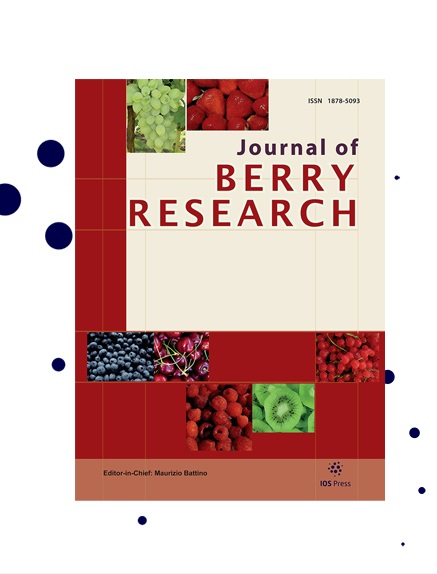Optimization of conventional solid-liquid extraction and microwave-assisted extraction of polyphenols and antioxidant compounds of blueberry (Vaccinium corymbosum) pomace through response surface methodology
IF 1.4
4区 农林科学
Q3 PLANT SCIENCES
引用次数: 1
Abstract
BACKGROUND: Blueberries contain large amounts of phenolic compounds as well as a higher concentration of anthocyanins than other berries. The peel of these fruits contains most of the anthocyanins and therefore pomace is left with the largest quantity of valuable phenolic compounds. Extraction is the most critical step to obtain such compounds. OBJECTIVE: This study aims to optimize the extraction of polyphenols and antioxidant compounds from blueberry pomace by solid-liquid extraction (SLE) and microwave-assisted extraction (MAE). METHODS: A Pareto chart was used to confirm the factor with the highest impact, response surface for analyzing the effect of extraction conditions on total phenol content (TPC) (through Folin-Ciocalteu), total anthocyanin content (TAC) (through differential pH), antioxidant capacity (AC) (through DPPH assay) and the Box-Behnken matrix to determine the optimal conditions for marc extraction with each method. RESULTS: Ethanol concentration is an impact factor for both methods, as well as irradiation method, radiation power for MAE and temperature for SLE. Regarding SLE and MAE extraction, under optimal conditions, a TCP content of 335.95 and 426.19 (mg GAE/100 g), TAC 272.69 and 389.64 (mg Cyn-3-glu/100 g), and CA 528.96 and 654.11 (mg TE/100 g) was obtained, respectively. CONCLUSIONS: The performance of phenolic compound extraction via MAE method is better than that of SLE.响应面法优化常规固液萃取和微波辅助萃取蓝莓渣多酚和抗氧化化合物
背景:蓝莓含有大量的酚类化合物,花青素的浓度也比其他浆果高。这些水果的果皮含有大部分花青素,因此果渣中含有最多有价值的酚类化合物。提取是获得此类化合物的最关键步骤。目的:采用固液萃取(SLE)和微波辅助萃取(MAE)两种方法对蓝莓渣中多酚和抗氧化化合物的提取工艺进行优化。方法:采用Pareto图确定影响最大的因素,响应面分析提取条件对总酚含量(TPC)(通过Folin-Ciocalteu)、总花青素含量(TAC),抗氧化能力(AC)(通过DPPH测定)和Box-Behnken基质来确定每种方法提取marc的最佳条件。结果:乙醇浓度是两种方法的影响因素,也是照射方法、MAE的辐射功率和SLE的温度的影响因素。关于SLE和MAE的提取,在最佳条件下,TCP含量分别为335.95和426.19(mg GAE/100 g) ,TAC 272.69和389.64(mg Cyn-3-glu/100 g) 和CA 528.96和654.11(mg TE/100 g) 分别获得。结论:MAE法提取酚类化合物的效果优于SLE法。
本文章由计算机程序翻译,如有差异,请以英文原文为准。
求助全文
约1分钟内获得全文
求助全文
来源期刊

Journal of Berry Research
Biochemistry, Genetics and Molecular Biology-Biochemistry
CiteScore
3.50
自引率
11.80%
发文量
21
期刊介绍:
The main objective of the Journal of Berry Research is to improve the knowledge about quality and production of berries to benefit health of the consumers and maintain profitable production using sustainable systems. The objective will be achieved by focusing on four main areas of research and development:
From genetics to variety evaluation
Nursery production systems and plant quality control
Plant physiology, biochemistry and molecular biology, as well as cultural management
Health for the consumer: components and factors affecting berries'' nutritional value
Specifically, the journal will cover berries (strawberry, raspberry, blackberry, blueberry, cranberry currants, etc.), as well as grapes and small soft fruit in general (e.g., kiwi fruit). It will publish research results covering all areas of plant breeding, including plant genetics, genomics, functional genomics, proteomics and metabolomics, plant physiology, plant pathology and plant development, as well as results dealing with the chemistry and biochemistry of bioactive compounds contained in such fruits and their possible role in human health. Contributions detailing possible pharmacological, medical or therapeutic use or dietary significance will be welcomed in addition to studies regarding biosafety issues of genetically modified plants.
 求助内容:
求助内容: 应助结果提醒方式:
应助结果提醒方式:


